
image by Guillermo T. Aveledo , 21 December 1999

Last modified: 2006-06-03 by dov gutterman
Keywords: venezuela | university |
Links: FOTW homepage |
search |
disclaimer and copyright |
write us |
mirrors
See also:
Other Sites:
The flag and coat of arms of the education institue Liceo
Bolivariano "Hilario Pizani Anselmi", located in
Motatán, shall be selected on 12 May 2006. The selection process
started on 11 May 2006 with the presentation of 38 flags and 38
coat of arms, one by section of the institute. For the second
round, 12 flags and 12 coats of arms have been kept.
Source: <www.diarioeltiempo.com.ve>.
Ivan Sache, 13 May 2006

image by Guillermo T. Aveledo , 21 December 1999
Universidad Central de Venezuela (Central University of
Venezuela; founded 1721).
Description: A white field (although sometimes light yellow or
even beige are used; there are no official specifications to this
flag besides the ones I'm giving) with the Seal of the University
and the date "1721" (date it was founded) on royal blue
(embroidered under the seal on roman type letters). The seal
consists of a few Academic and National symbols: Encircled by the
words "*Universidad Central* Caracas-Venezuela", we see
seven stars (as the ones in the national flag) over a shining oil
lamp (which symbolises enlightment and sums up the University's
motto: "the house that overcomes the shadows") which
sits on two books (philosophy and science), old papers and an
inkpot with a pen on a book (history). Branches of Cofee and Palm
encircle the lower part of the arrangement (as a connection to
the tropical reality the University stands in).
Guillermo T. Aveledo, 21 December 1999
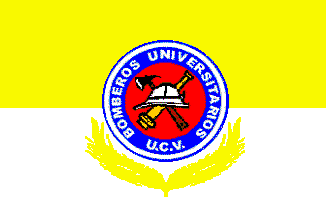
image by Guillermo T. Aveledo, 15 September 2000
Bomberos Universitarios - Universidad Central de Venezuela
(University Fire Brigade - Central University of Venezuela)
Guillermo T. Aveledo, 15 September 2000

image by Blas Delgado Ortiz, 20 April 2002
Néstor Garrido of Venezimbol presented the flag of the
Catholic University Andrés Bello (Universidad Católica Andrés
Bello). Its dimensions are not regulated. Its symbology is as
follows:
The flag is a horizontal triband of equal dimensions: blue, white
and yellow in descending order. Blue and white are the colors of
the Virgin Mary, and at the same time, white and yellow are the
Vatican’s colors, that certifies the Catholic and Marian
character of this University. The shade of blue is a dark sky
blue.
Blas Delgado Ortiz, 20 April 2002
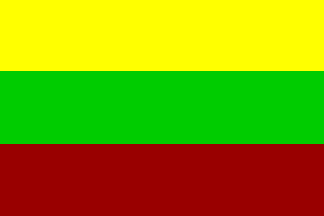
image by Ivan Sache, 9 June 2001
Universidad de Carabobo (Venezuela) - 2:3 (by default) flag,
horizontally divided yellow-green-dark red. The flag is shown on
<www.rectorado.uc.edu.ve>,
located by Dov Gutterman. Chapter III of the regulation
on the symbols of the University says the colour are 'Oro, Verde
y Purpura', symbolizing faith, liberty, and culture, respectively
(Article 5). The flag shall be hoisted on all buidings belonging
to the University (Faculties, Schools, Institutes, and Centers)
on Memorial Day of the reopening of the University and ceremony
days dedicated to professors, students, employees and other
members of the University (Article 7). The use of the flag in
otherinstances is subjected to the authorization of the Rector of
the University (Article 8).
Ivan Sache, 9 June 2001
At <www.uc.edu.ve>,
the flag appear with the Coat of Arms on the canton.
Dov Gutterman, 1 November 2004
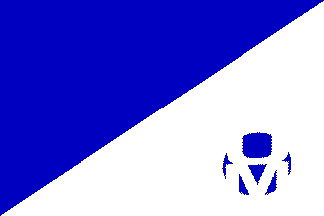
image by Dov Gutterman, 3 March 2002
The flag of this university is at <www.unimar.edu.ve>.
Dov Gutterman, 3 March 2002
The Flag of University of Margarita is dexter hoist; this is,
the hoist is see at the left of the observer and therefore the
logotipe appear on the lower fly. The prevailing vexillological
custom in Venezuela is that the flags are dexter hoisted or with
the hoist sees to left of the observer. We can describe the Flag
of University of Margarita in this way: a filed with approxcimate
ratio 2:3 diagonally divided from upper fly to lower hoist in two
stripes: blue and white, showing on this last one the logotipe of
the Institution (blue circle with letters U in superior part and
M in the inferior part, both white)
Raul Orta, 3 March 2003
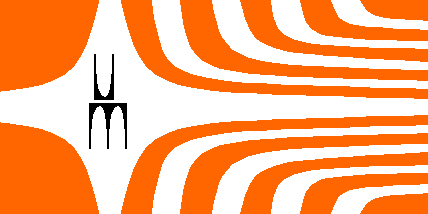
image by Guillermo T. Aveledo, 15 September 2000
Universidad Metropolitana - Metropolitan University - Caracas
Guillermo T. Aveledo, 15 September 2000

image by Dov Gutterman, 22 July 2002
unet.gif)
The Emblem
image by Raul Orta, 26 July
2002
Based on <www.unet.edu.ve>.
Dov Gutterman, 22 July 2002
The Flag - Attributes - The National Experimental University
of Táchira is an educational entity located on the Táchira
State, at the Southwest of Venezuela. Its flag consists of a
field with approximate ratio 2:3 or square and half of length,
horizontally divided on two stripes: white the superior and blue
the inferior. The Official Emblem of the Intitution in blue to
the canton completes the conjunct.
The Emblem - Attributes and Semiology - It consist in a super
streamlined and kinetic arrange of the letters U and T that
alludes to the name of the Institution.
Source: National Experimental University of Táchira Web
Site <www.unet.edu.ve>.
Raul Orta, 26 July 2002
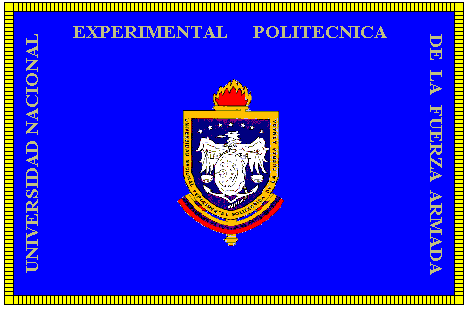
image by Raul Orta, 2 April 2003
unefa.gif)
image by Raul Orta, 2 April 2003
The standard and Coat of Arms of the National Experimental
Politechnic University of the Venezuelan Armed Force (Initials
UNEFA in Spanish), the former "University Politechnic
Institute of the National Armed Forces" (Initials IUPFAN in
Spanish)
1.- STANDARD - ATTRIBUTES - Consist in a regular (rectangular)
field with ratio 2:3; this is, square and half of longitude. On
its blue field gilded fringed appears the Coat of Arms of the
Institute in all its official attributes and surrounding it the
denomination "UNIVERSIDAD NACIONAL EXPERIMENTAL POLITECNICA
DE LA FUERZA ARMADA" (NATIONAL EXPERIMENTAL POLITECHNIC
UNIVERSITY OF THE VENEZUELAN ARMED FORCE) in golden roman capital
letters.
- SEMIOLOGY - Blue signs the Great Ideals, High Spirit, the
Loyalty and the Perseverance which anime the action and
activities which belongs to the Institute whilst its Coat of Arms
and denomination rebounds the privilege of the formation in its
classrooms making honor to its motto: "EDUCATIVE
EXCELLENCE".
2.- COAT OF ARMS .- ATTRIBUTES - Consist in an Spaniard shape
with only one quarter or simple Azure (blue) field which charges
an emblematic conjunct integrated by an eagle with downed wings
nascent from a tierced round shield superposed to an anchor and a
balance, with a constellation of seven five-pointed stars
disposed in arc on the chief, all in Argent (white). Border in Or
(yellow) with the inscription "UNIVERSIDAD NACIONAL
EXPERIMENTAL POLITÉCNICA DE LA FUERZA ARMADA"
("NATIONAL EXPERIMENTAL POLITECHNIC UNIVERSITY OF THE
VENEZUELAN ARMED FORCE") in gothic capital letters enameled
on Sable (black), disposed on the flanks and base of the Coat of
Arms. As external ornaments, the blazon shows a torch in Or
(yellow) flamed in the same enamel and Gules (red) disposed at
the back of the field and a pennant tierced in Or (yellow), Azure
(blue) and Gules (red) that charges as mottoes the ephemeris
"3 DE FEBRERO DE 1974" (February 3rd, 1974) and
"26 DE ABRIL DE 1999" (April 26th, 1999) in gothic
capital letters enameled in Sable (black).
- SEMIOLOGY - The field is enameled in Azure for sign the Great
Ideals, the High Spirit, the Loyalty and the Perseverance which
inspired the action and activities which belongs to the
Institute. The Constellation of seven five-pointed stars
symbolizes the Venezolanity and remembers the Constance in the
Services; by one hand and by the other, the shine of the Personal
and Professional Virtues of the Docent, Administrative and
Pupil's Personnel of the University. The central emblematic
conjunct symbolizes the union of the four components of
Venezuelan Armed Force: the round shield represents the Army; the
anchor remembers the Navy; the eagle symbolizes the Aviation and
the balance alludes to the National Guard: all enameled in Argent
for sign the Clarity, the Eloquence, the Integrity and the Truth
required of the Personnel adscript to the Institute in the
exercise of their functions The border in Or remembers the Joy,
the Constance, the Generosity and the Nobleness: virtues which
adorn who is called to conduce the destinies of the University
whilst its denomination rebound its Corporative Identity, Values,
Traditions and Objects. The torch represents the Knowledge and
the Study which encounter on the Institute's classrooms a
propitious and fecund place for its development and progress. The
pennant, reaffirmation of the Patriotic felling which encounters
echo in the Institute, shows the dates of its foundation and
elevation to the University range as a tribute to everyone who
formed and form a part of it for the realization of all that
contract its motto: EDUCATIVE EXCELLENCE for contribute
efficiently to the Progress of our Homeland.
3.- HISTÓRICAL SYNTHESIS - It was created by Colonel (Venezuelan
National Guard) MARIO MUÑOZ CABRERA. Initially was conceived for
represent INSTITUTO UNIVERSITARIO POLITÉCNICO DE LAS FUERZAS
ARMADAS NACIONALES (UNIVERSITY POLITECHNIC INSTITUTE OF NATIONAL
ARMED FORCES), which with the pass of the time was elevated to
the category that today have as UNIVERSIDAD NACIONAL EXPERIMENTAL
POLITECNICA DE LA FUERZA ARMADA - UNEFA (NATIONAL EXPERIMENTAL
POLITECHNIC UNIVERSITY OF THE VENEZUELAN ARMED FORCE).
Raul Orta, 2 April 2003
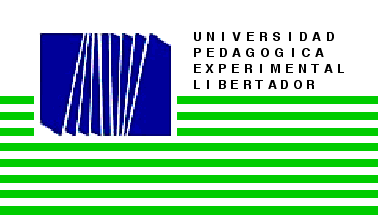
image by Ivan Sache, 10 August 2002
Universidad Pedagógica Experimental Libertador - The emblem
of the University was designed by the artist Alvaro Sotillo. It
is an abstract representation of nine books. Eight of these books
represent the eight Institutes which constitute the University,
and the ninth book represents the Rectoral Seat. In 1989, the
original grey colour of the books was changed to blue.
The flag has a white field with the emblem of the University in
upper left part and the name of the University beside it. In the
lower part of the flag, eight thin green stripes represent the
eight Institutes of the University. Green is the colour
traditionally associated to the Doctoral stuides in the UPEL.
UPEL was created by Decree #2176 of 28 July 1983 as an hommage to
Simon bolivar for the bicentenary of his birth.
Source: <www.upel.edu.ve>.
Ivan Sache, 10 August 2002
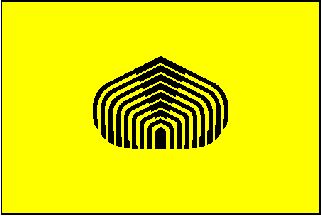
image by Raul Orta, 26 July 2002
usb.gif)
The Emblem
image by Raul Orta, 26 July
2002
Based on <www.usb.ve>.
Dov Gutterman, 22 July 2002
The Flag - Attributes - The Simon Bolivar University is an
educative entity located on Sartenejas Valley, Sucre Municipality
of Miranda State, very near Caracas. It flag consists of a yellow
field of approximated ratio 2:3 or square and half of length,
with the Institute Official Emblem in black on the center.
Historical Synthesis - The SBU flag' design was made on 1972,
when a group of professors were dedicated to the work to
conceive the elements for bring the sport delegations with an
emblem. In that opportunity, it was decided by a yellow rectangle
with the Institute's Emblem in black on the center and underneath
this one the abbreviations USB (Universidad Simon Bolivar in
Spanish). Later, on June 1987, it was decided the elimination of
the abbreviations. The official flag of Simon Bolivar University
is hoisted near to the National Flag of Venezuela, in National
and Institutional holidays, in the Benjamín Mendoza Hall:
the most important of the campus, in sport delegations, student
groupings and the Firemen Body of the Institution.
The Emblem - Attributes and Semiology - The figure is made up
with eight semicircular lines and a small rectangle placed on the
center forming a structure similar to a rounded pyramid, whose
meaning is a porch in which it's made the unity of diverse
knowledge and its projection towards the future.
Historical Synthesis - From the existing confluence between the
name "Simon Bolivar University" and its motto "the
University of the Future", the designer Gerd Leufert made
the design of the Emblem being inspired by the photographic
reproduction of an electrical circuit.
Source: Simon Bolivar University Web Site <www.usb.ve>.
Raul Orta, 26 July 2002
The logo of the University was designed by Gerd Leufert. It is
based on the photographical representation of an electrical
circuit. The logo is made of eight semi-circular lines arranged
around a small rectangle. The logo constitutes a portico which
symbolizes the unity of the different sciences and their
projection into the future. The flag of the University was
designed in 1972 by a group of professors in order to give the
sport team a flag. The first flag was yellow with the logo of the
University and its acronym USB. The acronym was suppressed from
the flag in June 1987. The flag of the University is hoisted side
by side with the Venezuelian national flag for the national and
institutional days, in the Benjamin Mendoza Hall, by the sport
teams, student associations and the fire brigade of the
University.
Ivan Sache, 10 August 2002
1)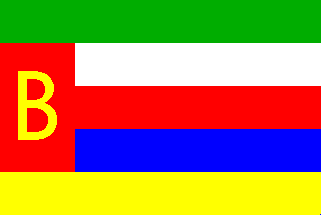
image by Guillermo T. Aveledo , 1 March 2000
2)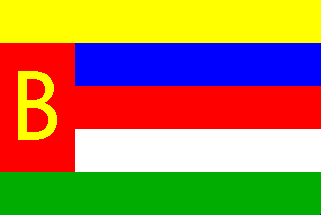
image by Guillermo T. Aveledo , 1 March 2000
Sociedades Bolivarianas Estudiantiles (Student Bolivarian
Societies) - The SBCs are societies formed throughout Venezuela's
schools in order to honour and cherish the thought and work of
Venezuela's Liberator Simon Bolivar, who led (or intervened
protagonically in) the wars of independance of six countries (or
countries to be) from Spanish rule: these countries are today's
Panama, Colombia, Venezuela (his birthplace), Ecuador, Bolivia
and Peru. These are the "bolivarian" countries (only
Venezuela has constitutionally declared itself a
"bolivarian" republic), whose flag colours serve as the
colours of the Student Bolivarian Societies flags: five stripes
of (from top to bottom or viceversa) yellow, blue, red, white and
green, with a yellow "B" on a red canton on the middle
of the hoist side, with the height of three of the stripes. These
flags are often seen in parades and on schoolyards.
I am not sure wether these flags are used in any of the other
"bolivarian" countries.
Guillermo T. Aveledo , 1 March 2000